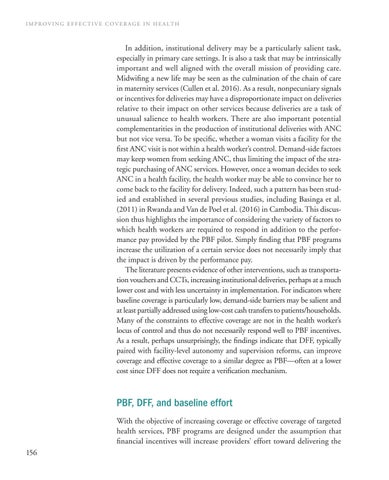IMPROVING EFFECTIVE COVERAGE IN HEALTH
In addition, institutional delivery may be a particularly salient task, especially in primary care settings. It is also a task that may be intrinsically important and well aligned with the overall mission of providing care. Midwifing a new life may be seen as the culmination of the chain of care in maternity services (Cullen et al. 2016). As a result, nonpecuniary signals or incentives for deliveries may have a disproportionate impact on deliveries relative to their impact on other services because deliveries are a task of unusual salience to health workers. There are also important potential complementarities in the production of institutional deliveries with ANC but not vice versa. To be specific, whether a woman visits a facility for the first ANC visit is not within a health worker’s control. Demand-side factors may keep women from seeking ANC, thus limiting the impact of the strategic purchasing of ANC services. However, once a woman decides to seek ANC in a health facility, the health worker may be able to convince her to come back to the facility for delivery. Indeed, such a pattern has been studied and established in several previous studies, including Basinga et al. (2011) in Rwanda and Van de Poel et al. (2016) in Cambodia. This discussion thus highlights the importance of considering the variety of factors to which health workers are required to respond in addition to the performance pay provided by the PBF pilot. Simply finding that PBF programs increase the utilization of a certain service does not necessarily imply that the impact is driven by the performance pay. The literature presents evidence of other interventions, such as transportation vouchers and CCTs, increasing institutional deliveries, perhaps at a much lower cost and with less uncertainty in implementation. For indicators where baseline coverage is particularly low, demand-side barriers may be salient and at least partially addressed using low-cost cash transfers to patients/households. Many of the constraints to effective coverage are not in the health worker’s locus of control and thus do not necessarily respond well to PBF incentives. As a result, perhaps unsurprisingly, the findings indicate that DFF, typically paired with facility-level autonomy and supervision reforms, can improve coverage and effective coverage to a similar degree as PBF—often at a lower cost since DFF does not require a verification mechanism.
PBF, DFF, and baseline effort With the objective of increasing coverage or effective coverage of targeted health services, PBF programs are designed under the assumption that financial incentives will increase providers’ effort toward delivering the 156

